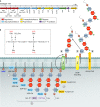Pneumococcal Capsules and Their Types: Past, Present, and Future
- PMID: 26085553
- PMCID: PMC4475641
- DOI: 10.1128/CMR.00024-15
Pneumococcal Capsules and Their Types: Past, Present, and Future
Erratum in
-
Erratum for Geno et al., "Pneumococcal Capsules and Their Types: Past, Present, and Future".Clin Microbiol Rev. 2020 Dec 23;34(2):e00320-20. doi: 10.1128/CMR.00320-20. Print 2021 Mar 17. Clin Microbiol Rev. 2020. PMID: 33361144 Free PMC article. No abstract available.
Abstract
Streptococcus pneumoniae (the pneumococcus) is an important human pathogen. Its virulence is largely due to its polysaccharide capsule, which shields it from the host immune system, and because of this, the capsule has been extensively studied. Studies of the capsule led to the identification of DNA as the genetic material, identification of many different capsular serotypes, and identification of the serotype-specific nature of protection by adaptive immunity. Recent studies have led to the determination of capsular polysaccharide structures for many serotypes using advanced analytical technologies, complete elucidation of genetic basis for the capsular types, and the development of highly effective pneumococcal conjugate vaccines. Conjugate vaccine use has altered the serotype distribution by either serotype replacement or switching, and this has increased the need to serotype pneumococci. Due to great advances in molecular technologies and our understanding of the pneumococcal genome, molecular approaches have become powerful tools to predict pneumococcal serotypes. In addition, more-precise and -efficient serotyping methods that directly detect polysaccharide structures are emerging. These improvements in our capabilities will greatly enhance future investigations of pneumococcal epidemiology and diseases and the biology of colonization and innate immunity to pneumococcal capsules.
Copyright © 2015, American Society for Microbiology. All Rights Reserved.
Figures










References
-
- White B. 1938. The biology of pneumococcus. The Commonwealth Fund, New York, NY.
-
- World Health Organization. 2007. Pneumococcal conjugate vaccine for childhood immunization—WHO position paper. Wkly Epidemiol Rec 82:93–104. - PubMed
Publication types
MeSH terms
Substances
Grants and funding
LinkOut - more resources
Full Text Sources
Other Literature Sources
Miscellaneous

